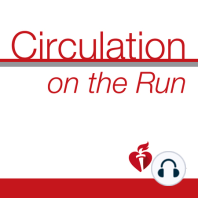16 min listen
Circulation June 15, 2021 Issue
ratings:
Length:
26 minutes
Released:
Jun 14, 2021
Format:
Podcast episode
Description
Join Mercedes Carnethon as she interviews authors Brendon Bellows, Dhruv Kazi, and Kirsten Bibbins-Domingo to discuss two articles published in the special issue: “Cost-effectiveness of Hypertension Treatment by Pharmacists in Black Barbershops” (https://www.ahajournals.org/doi/10.1161/CIRCULATIONAHA.120.051683 ) and “Scaling Up Pharmacist led Blood Pressure Control Programs in Black Barbershops: Projected Population Health Impact and Value” https://www.ahajournals.org/doi/10.1161/CIRCULATIONAHA.120.051782. Dr. Joseph Hill: Welcome to Circulation on the Run. My name is Joe Hill and I'm the editor-in-chief of Circulation. In recent months, we witnessed horrific acts of discrimination and violence against African-Americans. We are shocked and appalled, but yet we also recognize that this is in many ways nothing new. At Circulation, we are highly committed, longstanding commitment to shining a bright light on these pervasive inequities. And we are not willing to simply catalog the woefully longstanding racism that pocks our society, but rather we intend to shine a bright light on solutions. And with that, we are launching the first annual issue on disparities in cardiovascular medicine. This will be released in mid June corresponding to the date of Juneteenth, which is the date in the 19th century when a group of slaves in Galveston, Texas was apprised of the fact that they were no longer slaves now for two years. Dr. Joseph Hill: I'm honored to have our three editors who are running this podcast and this issue with us, they are Dr. Mercedes Carnethon from Northwestern University, Dr. Karol Watson from UCLA, both of whom are associate editors with the journal. And I'm pleased that Michelle Albert, who is one of our senior guest editors at UCSF will be joining us. These three professionals have led this initiative and I would like to spend a few minutes talking with them about this. First let's turn to Michelle if I may. Michelle, what do you think is required from a workforce perspective to make headway, to eliminate these disparities? Dr. Michelle Albert: Thank you, Dr. Hill. And I would first say that it is an honor to have been able to participate in this disparities issue focused on African-Americans and health. First, I think that it is important for our audience to understand that the metrics actually behind a workforce. In cardiovascular medicine, only 13% of fellows are underrepresented fellows, meaning black or African American, Hispanic, or Latinx, native Americans, Alaska natives, and Pacific Islanders. And only 9% of faculty are UIM in cardiovascular medicine. This stems from a pipeline or pathway issues that go all the way back to kindergarten and middle school. Indeed, over the last three decades only, although there's been a 50% increase in applications for blacks and Hispanics, the applications have only increased by 1.2% and there has been a drop in Alaska native and American Indian applications by 30%. Dr. Michelle Albert: So with regards to how improve these statistics, we have to have multifaceted approaches related to understanding pipeline barriers, which include things like lack of encouragement, lack of role models and paying attention to recruitment, but not just the only recruitment at the pre-medical level, immediate pre-medical level, but way prior to the pre-med level, we have to engage middle-aged and high school students in STEM and thereafter at the pre-medical level, we have to make sure that students get the appropriate advice to ensure successful careers in college that would then engender successful applications to medical school. Dr. Michelle Albert: Once we get into the actual medical institutional systems, we have to address structural barriers to discrimination that exist, that impede the progress through pathways in medicine. And these barriers exist at the medical school level, the residency level, fellowship level and faculty to leadership levels. I would say just a couple of examples at
Released:
Jun 14, 2021
Format:
Podcast episode
Titles in the series (100)
Circulation August 30, 2016 Issue: Circulation Weekly: Your Weekly Summary & Backstage Pass To The Journal by Circulation on the Run
